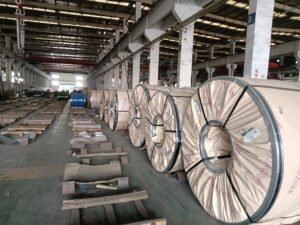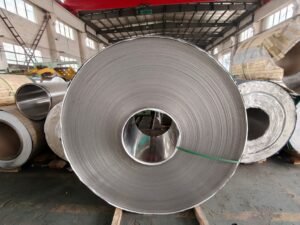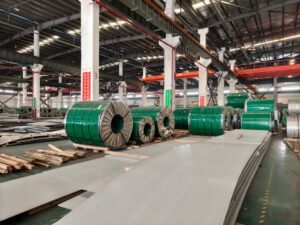Introduction
Harsh environments like coastal zones or industrial settings can wreak havoc on materials, and carbon steel often faces the brunt of corrosion risks. For engineers and construction pros, the challenge is clear: how do you ensure durability without breaking the bank?
Thankfully, with the right protective coatings and strategies, carbon steel can stand up to moisture, salt, and heat. This guide breaks down its performance under stress, explores top coatings like zinc galvanizing, and offers insights for outdoor or coastal applications. Let’s dive into making informed, cost-effective choices.
Corrosion Risks and Environmental Stressors for Carbon Steel
When it comes to building strong, lasting structures, carbon steel is a popular choice due to its strength and affordability. But, this material isn’t invincible, especially when exposed to tough environmental conditions. In this chapter, we’ll break down the risks it faces, like rust and wear, and why understanding these challenges can help you make smarter choices for your projects.
Carbon steel faces a big enemy: corrosion. This happens when the metal reacts with elements like moisture or salt, slowly breaking down over time. Whether you’re near the ocean or in a busy industrial zone, these factors can speed up the damage, making protective steps a must.
Understanding how moisture and salt affect carbon steel can help industries choose the right protective coatings to extend material lifespan.
Corrosion Mechanisms: How Moisture and Salt Accelerate Degradation
Picture this: water sits on a steel beam for too long, and before you know it, rust starts forming. Moisture creates a perfect setting for corrosion by allowing oxygen to interact with the metal surface. Add salt to the mix, like in coastal areas, and the process gets even faster, eating away at the steel’s strength.
Coastal Environments: Impact of High Humidity and Saline Conditions
Near the ocean, high humidity and salty air are a real pain, or as some might say, a total **”drag”**. The salt in the air acts like a catalyst, speeding up rust in ways fresh water alone can’t match. For structures like bridges or piers, carbon steel performance in harsh environments becomes a top concern without proper care.
Industrial Settings: Chemical Exposure and High-Temperature Effects
In factories or plants, steel often deals with harsh chemicals and extreme heat. These conditions can strip away natural defenses, leading to faster breakdown. Knowing how to protect carbon steel from corrosion in these spots can save costly repairs down the line.
Case Studies: Real-World Examples of Environmental Damage
Take a look at coastal oil rigs or industrial pipelines—many have faced early failure due to rust and wear from their surroundings. These real examples show why planning for corrosion resistance of carbon steel is critical. Solutions like specialized coatings or careful material selection, such as options offered by experts like HnL Steel, can make a huge difference in high-risk areas.
Environmental Impact on Carbon Steel: Key Data Comparison
| Environment Type | Corrosion Rate (mm/year) | Primary Stressor | Impact Level (1-10) | Protection Needed |
|---|---|---|---|---|
| Coastal (High Salinity) | 0.2-0.5 | Salt Air | 9 | Heavy Coatings |
| Industrial (Chemical Exposure) | 0.3-0.7 | Acidic Vapors | 8 | Specialized Sealants |
| Urban (Moderate Humidity) | 0.1-0.3 | Pollution | 6 | Basic Coatings |
| Rural (Low Stress) | 0.05-0.1 | Moisture | 3 | Minimal Protection |
| High-Temperature Zones | 0.4-0.8 | Heat + Oxidation | 7 | Heat-Resistant Layers |
Note: Corrosion rates are based on industry studies under typical conditions (e.g., ISO 9223 standards). Impact level reflects potential damage severity, guiding the urgency of protective measures. These figures help users prioritize solutions for better carbon steel performance in harsh environments.
Exploring challenges like these helps pinpoint where extra care is needed. Whether it’s picking pre-coated options or seeking advice from experienced suppliers like HnL Steel, small steps can lead to big savings in durability. Stick around as we dive deeper into protective solutions in later sections to keep your projects strong.

Best Coatings for Carbon Steel: Enhancing Durability in Harsh Conditions
Carbon steel is a go-to material for many projects thanks to its strength and low cost. But when it’s up against tough environments like salty air or chemical exposure, it can rust fast without the right protection. In this chapter, we’ll explore the best coatings for carbon steel to keep it strong and lasting, no matter the conditions.
Choosing the right protective coating for carbon steel can significantly extend its lifespan in harsh environments, saving money and effort over time.
Overview of Protective Coatings: Epoxy, Zinc Galvanizing, and Polyurethane
When it comes to shielding carbon steel, there are a few top players. Epoxy coatings act like a tough barrier against moisture, while zinc galvanizing—think of it as a protective armor—sacrifices itself to prevent rust. Then there’s polyurethane, which adds a durable, flexible layer that stands up to scratches and weather.
Benefits of Each Coating: Corrosion Resistance and Longevity
Each of these carbon steel coatings has unique strengths. Epoxy is amazing for stopping corrosion in wet areas, zinc galvanizing shines in salty conditions like near the coast, and polyurethane offers extra toughness against wear and tear. Picking one can mean the difference between a project that lasts years versus one that needs fixing ASAP.
Application Methods and Considerations for Optimal Results
Applying these coatings isn’t just a paint-and-go job—it’s gotta be done right to stick, or it’s a real bummer. Surface prep, like cleaning off dirt and rust, is key before spraying or dipping the steel. Factors like drying time and even weather during application can affect how well the coating holds up.
Choosing the Right Coating Based on Environmental Exposure
Not every environment is the same, so matching a coating to your setting is crucial. Coastal areas need heavy-duty options like zinc galvanizing to fight salt, while industrial zones might call for epoxy to handle chemicals. Knowing the best coatings for carbon steel in harsh environments can protect your investment for the long haul.
Coating Performance for Carbon Steel in Harsh Conditions
| Coating Type | Corrosion Resistance (1-10) | Durability (Years) | Best Environment | Application Complexity |
|---|---|---|---|---|
| Epoxy | 8 | 5-10 | High Humidity | Moderate |
| Zinc Galvanizing | 9 | 10-20 | Coastal/Saline | High |
| Polyurethane | 7 | 5-15 | Industrial Wear | Moderate |
| Alkyd | 6 | 3-7 | Mild Urban | Low |
| Bituminous | 5 | 5-10 | Underground | Low |
Note: Resistance and durability ratings are based on industry standards (e.g., ISO 12944). Application complexity reflects skill and equipment needed, helping users weigh cost versus effectiveness. These stats guide selection for optimal carbon steel coatings in tough settings.
Working with trusted suppliers like HnL Steel can make this process easier. They offer pre-coated steel options tailored for tricky spots like coastal or industrial zones, ensuring quality without the guesswork. Stick with us as we uncover more tips to keep your projects in top shape.

Carbon Steel vs. Stainless Steel: Comparing Performance in Harsh Environments
Choosing between carbon steel and stainless steel can be a tough call for any project, especially when harsh conditions are in play. Both materials have their strengths, but they shine in different ways. In this chapter, we’ll break down carbon steel vs stainless steel to help you decide which fits your needs best.
Comparing carbon steel and stainless steel based on corrosion resistance and cost can guide professionals to the most practical material for harsh environments.
Inherent Corrosion Resistance: Stainless Steel’s Advantage
Stainless steel often takes the lead when it comes to fighting rust. Thanks to its chromium content, it forms a protective layer that blocks corrosion, even in wet or salty areas. This makes it a top pick for places like coastal zones where moisture is a constant threat.
Cost-Effectiveness: Carbon Steel with Coatings as a Viable Alternative
Carbon steel, on the other hand, is easier on the wallet but needs some help to stand up to tough environments. With the right coatings like zinc or epoxy, it can hold its own against rust. This combo often makes it a smart, budget-friendly choice for many projects.
Performance Metrics: Strength, Durability, and Maintenance Needs
Let’s talk numbers—stainless steel tends to last longer without much upkeep, while carbon steel might need regular care to stay in shape. Stainless offers consistent durability, but it’s heavier on the upfront cost. Carbon options, when protected, can match that strength at a lower price, though you’ll need to stay on top of maintenance.
Best Use Cases: When to Choose Carbon Steel Over Stainless Steel
So, when does one beat the other in the matchup of carbon steel vs stainless steel? If you’re in a mild setting and watching your budget, coated carbon steel is a solid bet—honestly, it’s a total **”steal”**. But for extreme corrosion risks with no room for error, stainless might be worth the splurge.
Performance Comparison: Carbon Steel vs Stainless Steel
| Metric | Carbon Steel (Uncoated) | Carbon Steel (Coated) | Stainless Steel | Typical Application |
|---|---|---|---|---|
| Corrosion Resistance (1-10) | 2 | 7 | 9 | Coastal/Industrial |
| Cost per Ton (USD) | 600-800 | 700-900 | 2000-3000 | Budget Constraints |
| Tensile Strength (MPa) | 400-550 | 400-550 | 500-700 | Structural Loads |
| Maintenance Frequency | High | Moderate | Low | Long-Term Use |
| Lifespan (Years) | 5-10 | 10-20 | 20-30 | Harsh Exposure |
Note: Data reflects industry averages (e.g., ASTM standards). Cost and lifespan vary by environment; coatings boost carbon steel’s viability. This helps answer how to protect carbon steel from corrosion effectively.
Teaming up with experts like HnL Steel can simplify this choice. They provide coated carbon steel options that rival stainless steel’s performance at a lower cost, backed by flexible payment and fast delivery. Keep reading for more insights on making the most of your material pick.

Practical Strategies for Using Carbon Steel in Outdoor and Coastal Applications
Carbon steel is a popular pick for many outdoor projects due to its strength and affordability. But in harsh settings like coastal areas, it needs extra care to stay in top shape. This chapter gives you practical tips to make the most of carbon steel in tough environments, from maintenance to smart partnerships.
“Implementing regular maintenance and choosing the right coatings for carbon steel can drastically improve its performance in outdoor and coastal settings.”
Maintenance Best Practices: Regular Inspections and Re-Coating Schedules
Keeping an eye on your steel structures can save you a ton of trouble. Schedule routine checks to spot rust early, and stick to a re-coating plan—think of it as a fresh shield against the elements. This is especially key for industrial applications of carbon steel near the sea.
Environmental Factors in Material Selection: Humidity and Corrosion Risk
Before picking materials, consider where they’ll be used. High humidity and salty air in coastal zones speed up rust, so understanding corrosion resistance of carbon steel is a big deal. Opt for pre-treated options to combat these risks right from the start.
Partnering with Trusted Suppliers for Coated Inventory Availability
Working with reliable suppliers can be a real **”lifesaver”** when you’re dealing with harsh conditions. Companies like HnL Steel offer quality-coated steel ready for outdoor challenges, plus fast delivery to keep your project on track. Their personalized support helps match materials to your specific needs.
Lifecycle Cost Analysis: Balancing Durability and Budget
Think long-term when budgeting for steel projects. While upfront costs matter, durability saves money over time—especially in applications for carbon steel in construction. Weighing maintenance expenses against initial price helps you find the sweet spot for value.
Maintenance Strategies for Carbon Steel in Harsh Environments
| Strategy | Frequency | Cost Impact (1-10) | Environment Suitability | Effectiveness (1-10) |
|---|---|---|---|---|
| Visual Inspections | Monthly | 2 | All Outdoor | 7 |
| Re-Coating (Epoxy) | Every 3-5 Years | 5 | Coastal/High Humidity | 8 |
| Galvanizing Touch-Up | Every 5-7 Years | 6 | Saline Areas | 9 |
| Rust Inhibitor Spray | Annually | 3 | Mild Outdoor | 6 |
| Structural Cleaning | Every 6 Months | 4 | Industrial/Coastal | 7 |
Note: Frequency and effectiveness are based on industry practices (e.g., ISO 12944 guidelines). Cost impact reflects relative expense, aiding budget planning for outdoor projects. These strategies boost corrosion resistance of carbon steel significantly.
Using these tips, you can tackle the challenges of harsh settings with confidence. Suppliers like HnL Steel stand by to ensure you’ve got the right materials and advice for lasting results. Keep these ideas in mind as we explore more ways to strengthen your projects.
Conclusion
Looking at how carbon steel holds up in brutal conditions, I’ve realized it’s all about smart choices. With the right coatings and maintenance, this material can tackle rust and wear, even in coastal or industrial zones, without costing a fortune.
From my decade in the steel game, I can say with confidence that protecting carbon steel isn’t just a one-time fix—it’s a long-term strategy. Partnering with a trusted supplier who gets your needs, like we do at HnL Steel, makes it a no-brainer to keep your projects strong and durable.
So, as you plan your next build, think about how the right solutions can save you headaches down the road. What steps will you take to shield your materials from the elements?
FAQ
Q1: What are the environmental effects of carbon steel?
A1: The environmental effects of carbon steel primarily relate to its corrosion resistance and associated emissions. When not properly coated or maintained, carbon steel can corrode, leading to metal degradation and impacting ecosystems.
Q2: How does humidity affect carbon steel corrosion?
A2: Humidity plays a significant role in the corrosion of carbon steel. Higher humidity levels accelerate the oxidation process, which can lead to rust formation, reducing the durability and lifespan of carbon steel products.
Q3: What types of coatings are best for carbon steel in harsh environments?
A3: Best coatings for carbon steel in harsh environments include epoxy, polyurethane, and zinc-rich paints. These coatings create a barrier that protects against moisture and corrosive agents, significantly enhancing the steel’s life expectancy.
Q4: How can carbon steel be protected from corrosion?
A4: Carbon steel can be protected from corrosion through various methods including applying protective coatings, galvanization, and regular maintenance. These approaches help to reduce the steel’s exposure to moisture and corrosive substances.
Q5: What is the difference in corrosion resistance between carbon steel and stainless steel?
A5: Stainless steel generally offers higher corrosion resistance than carbon steel due to its chromium content, which forms a protective oxide layer. Carbon steel, however, is more prone to corrosion without protective coatings.
Q6: What are the advantages of using carbon steel in industrial applications?
A6: Carbon steel is favored in industrial applications due to its high strength, affordability, and versatility in manufacturing. It can be treated and coated to improve its durability and performance in various environments.
Q7: What are carbon steel’s performance traits in harsh environments?
A7: In harsh environments, carbon steel exhibits good toughness and strength but is susceptible to corrosion. Proper coatings and treatment can enhance its durability and extend its operational lifespan.
Q8: What types of carbon steel are recommended for construction?
A8: Mild steel and medium carbon steel are commonly recommended for construction purposes due to their balance of workability, toughness, and strength, making them suitable for structural applications.
External Links
- Carbon Steel – Wikipedia
- All About Carbon Steel as a Manufacturing Material | Xometry
- Understanding Carbon Steel | Metal Casting Blog
- An Overview of Carbon Steel – AZoM
- What are the differences between carbon steel and stainless steel?
- Pros and Cons of Carbon Steel: What You Should Know | OneMonroe
- Differences Between Carbon Steel and Stainless Steel
- Mild Steel vs. Carbon Steel: What’s Their Difference?





